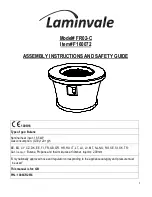
42
You have become the owner of a Flamingo fireplace hot-air insert from the renowned
manufacturer HS Flamingo s.r.o.
Thank you for the trust you have shown in purchasing our product. Please read this Operation Manual carefully,
as it gives information about the function and handling of the fireplace insert. This avoids the risk of damage
and prolongs the life of the insert.
CONNECTION AND FIRST COMMISSIONING MAY BE CARRIED OUT EXCLUSIVELY BY A QUALIFIED PERSON
WHO HAS THE APPROPRIATE AUTHORIZATION AND KNOWLEDGE OF APPLICABLE STANDARDS!
Proper operation saves fuel and protects the environment.
We only provide a guarantee for our products if you follow the Installation Instructions and Operation Manual.
Keep the Instructions and the Technical Information carefully so that you are able to refresh the knowledge
needed for the correct operation of the purchased product at the beginning of each heating season.
1.
TECHNICAL SPECIFICATIONS
The fireplace hot-air insert is intended for heating living rooms, recreational facilities and workplaces, where the
intention is to increase thermal comfort, which is also contributed to by the visual perception of watching an
acutal flame. Compared to a classic open fireplace, it has a much higher thermal efficiency. Another advantage
of the fireplace insert is its high degree of safety without the risk of embers flying out as well as the limitation of
the spread of flue gases into the heated space. The heating of the air in the room and the creation of a cozy living
climate (thermal comfort) is achieved mainly by convection heat, but partly also by radiant heat. With this system,
even very cold, long-unheated rooms can be heated very quickly. The principle of convection heating consists
in the fact that the air from the room enters the heater’s lower part and, when moving upwards, it is heated in
the convection space formed by the double wall of the heater or its enclosure. It subsequently flows back to the
room through openings in the upper part of the insert or its enclosure. Radiant heat is obtained from the surface
of the heater (metal, lining, glass). Given the structure, the largest source of radiant heat is the glass door area.
Design
The insert is designed and intended exclusively for burning wood or wood briquettes. Coal and coke may not be
burned in the insert.
The insert is welded from 1.5–6 mm thick steel sheets. There is a combustion chamber in the middle part of the
insert, the front side of which can be closed by means of a stoking door, which is provided with a self-closing
mechanism. The door contains special large glass, which can withstand high temperatures of up to 750 °C. The
combustion chamber and the bottom are lined with vermiculite blocks. The blocks are not bound by any patching
material. There is a barrier in front of the combustion chamber to prevent fuel falling out and spontaneously
sliding to the front glass. The inserts are designed as double-walled with vertical flue gas discharge. The diameter
of the flue is 150 or 200 mm according to the type of insert, see the Technical Information. The casing of the in
-
serts is made of sheet steel. Convection openings in the lower part of the insert are intended for air supply to the
intermediate space of the insert casing, outlets in the upper part (flanges for M9 and X15) enable connection to
hot air distribution for subsequent distribution around the building. The steel structure of the insert is protected
by a special heat-resistant paint.
Caution:
Fireplace hot-air inserts do not have the character of a permanent heater and are intended for periodic
– intermittent (temporary) operation. The fireplace insert should not be the only source of heat in the building.
2.
COMBUSTION PROCESS
2.1. Amount of fuel and combustion process setting
Wood combustion in fireplace inserts is a heat-through system, which means that the combustion happens in the
entire fuel batch at once. To ensure optimal conditions for easy kindling and subsequent flare up, it is necessary to
supply a sufficient amount of air under the burning fuel through the vents, marked as primary, which is adjustable
(variant with automatic regulation). As the flue gas temperature increases, the gaseous components of the fuel
begin to be released, which would not perform any thermal energy-based work without additional air supply, so
it is advisable to get additional preheated air to the level of flames, where the subsequent combustion process of
these gaseous substances can continue, which usually means that there is no need for primary air supply and, on
the contrary, the need for the supply of secondary air arises.
Содержание FLAMINGO M9
Страница 11: ...11 CZ PL DE EN FR SK ...
Страница 21: ...CZ PL DE EN FR SK 21 ...
Страница 31: ...31 CZ PL DE EN FR SK ...
Страница 51: ...CZ PL DE EN FR SK 51 ...
Страница 61: ... P7 Remplacement du verre P8 Assemblage du cadre P9 GARANTIE CZ PL DE EN FR SK 61 ...
















































